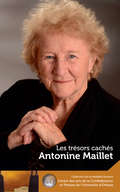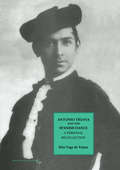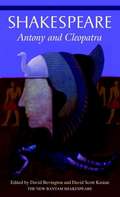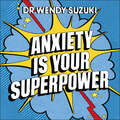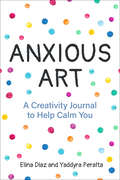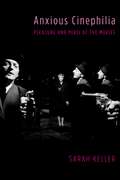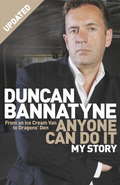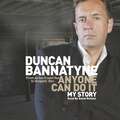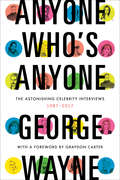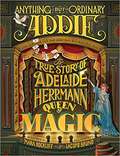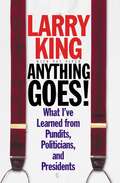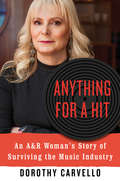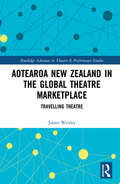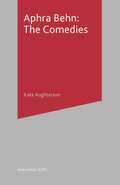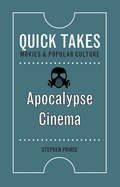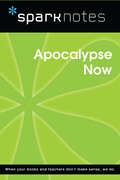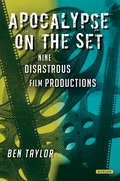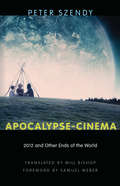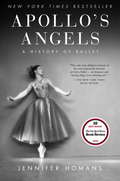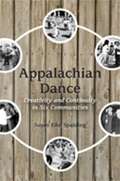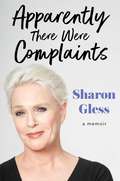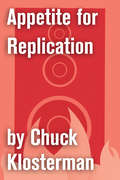- Table View
- List View
Antonine Maillet: Les trésors cachés - Our Hidden Treasures (The Symons Medal Series/Collection de la Médaille Symons)
by Antonine MailletA veritable artist, Maillet becomes a “creator of sounds, of colours, of forms and words.” As she speaks, she paints a vast landscape of mountains and oceans, history and story, using the tools on her palette: blending the colours of myths and those of contemporary issues, creating an epic poem in a profoundly personal voice. This country she portrays is both young and old, speaks two languages, has a rich subconscious, and aspirations. She ends her lecture by re-telling a story originally written by Rabelais— which, incidentally, was penned the same year as the discovery of America. The grande dame of storytelling uses her art to make an appeal for solidarity, in favour of the protection of cultures and the preservation of languages. Will her country, she asks, the one made “of many faces” and paradoxes, “be able to give nations of diverse origins their rightful place?” Renowned, notably, for her iconic play La Sagouine, Antonine Maillet received the prestigious Prix Goncourt for her novel Pélagie-la-Charette, thereby becoming the first non-European laureate of the most prestigious award in France. Since then, she has published over twenty novels and many plays, and also translated several celebrated authors such as Shakespeare. She is the recipient of numerous literary awards, including the Governor General Literary Award, the Royal Society of Canada’s Lorne Pierce Medal, and the Prix Goncourt. This book is bilingual.
Antonio Triana and the Spanish Dance: A Personal Recollection (Choreography and Dance Studies Series #Vol. 6)
by Rita Vega de TrianaThis book also traces the evolution of the Spanish Dance technique, marked as it is by a turbulent history. Antonio Triana was a dancer of mature artistry, dignity and power. His physical and technical achievements went beyond what is generally known about Spanish Dance. His dance presented the essence of the Spanish character and, in his choreography, he used his traditional background for his brilliant inspirations. He partnered the legendary La Argentinita, Pilar Lopez and Carmen Amaya with spirit and gallantry. Over the years he developed a very distinct method of teaching and he became one of the foremost Spanish Flamenco dancers and teachers of his time. Rita Vega de Triana formed the Triana Ballet Español with her late husband. She currently teaches Hispanic dance and related subjects at the University of Texas at El Paso and directs her own school as well as performing around the United States as a guest artist and choreographer.
Antony and Cleopatra
by William Shakespeare David Bevington David Scott Kastan James Hammersmith Robert Kean Turner Joseph PappA magnificent drama of love and war, this riveting tragedy presents one of Shakespeare's greatest female characters--the seductive, cunning Egyptian queen Cleopatra. The Roman leader Mark Antony, a virtual prisoner of his passion for her, is a man torn between pleasure and virtue, between sensual indolence and duty... between an empire and love. Bold, rich, and splendid in its setting and emotions,Antony And Cleopatra ranks among Shakespeare's supreme achievements.
Anxiety is Your Superpower: Using anxiety to think better, feel better and do better
by Dr Wendy SuzukiThis is cutting-edge science packaged as a practical guide on how to flip anxiety on its head and harness it as a superpower - by world-renowned neuroscientist, Dr Wendy Suzuki.We live in an age of anxiety. Like an omnipresent yet invisible odour you've grown used to, anxiety has become a constant condition, a fact of life, and a distraction that undermines our quality of life. Dr Wendy Suzuki's ground-breaking research will show us that science tells us a very different story: yes, anxiety is unpleasant - it's meant to be - and in the debilitating extreme, what Wendy will call 'bad anxiety', it's destructive. But most of the anxiety that humans feel is essential - not only to survival, but for higher brain functions formerly thought to be put on hold during anxious moments, Wendy will provide two broad categories of neuroscience-based hacks for harnessing anxiety and facing it head-on. The first will help address and calm anxiety so that you can enjoy the productivity you will experience, and the second grouping of brain science hacks will enable readers to channel anxious feelings into six uses for good anxiety - from productivity, increased emotional intelligence and focus to creativity and confidence. Through Wendy's unique perspective as a neuroscientist, she will teach us how to flip anxiety on its head and offer a counterintuitive lens through which to understand how anxiety manifests in our everyday lives. The book will introduce a taboo breaking slant on anxiety: we will learn how it can be good for us and that once we learn how to play it at its own game, it can become our superpower! (P)2020 Hodder & Stoughton Limited
Anxious Art: A Creativity Journal to Help Calm You
by Yaddyra PeraltaDecompress Your StressAnxious Art is for readers and doodlers seeking relief from anxiety and stress through meditative, creative processes.What if we took our stress and used it to create art that brings us peace?A 2016 study at Drexel university that examined the effects of creative activity on reducing levels of the stress hormone cortisol discovered that “45 minutes of art making…resulted in statistically significant lowering of cortisol levels.” We all know cortisol is the stress hormone, so grab a pen or pencil and let the meditations and writing prompts in this mindfulness journal take you on a calming journey to a healthier, happier mind.T.S. Eliot once said, “Anxiety is the handmaiden of creativity,” but if he had this creative journal during times of worry, he surely would have said creativity was the handmaiden to peace. With this friendly, calming companion, you will find that you are much more present in the here and now.A unique guided journal that will calm and inspire: When used as self-expression, creativity can allow us to take part in what psychologists call “sublimation,” or the transformation of negative or socially unacceptable impulses into socially acceptable or even beautiful creations. Anxious Art offers inventive prompts, art projects, and affirmations to inspire artistic activities that distract from feelings of distress and anxiety. As you experience this transformative guided journal, you will work with:Lyrical affirmations that build self-confidence and reduce fearTherapeutic writing exercises that root you in the present and spark joyDoodling that calms your emotionsGuided breathing exercises that bring you into the present momentFans of Wreck This Journal, Tiny Buddha’s Worry Journal, or I Am Her Now, will love the calming benefits of Anxious Art.
Anxious Cinephilia: Pleasure and Peril at the Movies (Film and Culture Series)
by Sarah KellerThe advent of new screening practices and viewing habits in the twenty-first century has spurred a public debate over what it means to be a “cinephile.” In Anxious Cinephilia, Sarah Keller places these competing visions in historical and theoretical perspective, tracing how the love of movies intertwines with anxieties over the content and impermanence of cinematic images.Keller reframes the history of cinephilia from the earliest days of film through the French New Wave and into the streaming era, arguing that love and fear have shaped the cinematic experience from its earliest days. This anxious love for the cinema marks both institutional practices and personal experiences, from the curation of the moviegoing experience to the creation of community and identity through film festivals to posting on social media. Through a detailed analysis of films and film history, Keller examines how changes in cinema practice and spectatorship create anxiety even as they inspire nostalgia. Anxious Cinephilia offers a new theoretical approach to the relationship between spectator and cinema and reimagines the concept of cinephilia to embrace its diverse forms and its uncertain future.
Anyone Can Do It: My Story
by Duncan BannatyneAt 30, Duncan Bannatyne had no money and was enjoying life on the beaches of Jersey. He saw a story of someone who had made himself a millionaire, and decided to do the same. Five years later he had done it, and now he is worth £168 million. <P><P>In this remarkable book, Bannatyne relives his colourful path to riches, from ice cream salesman to multi-millionaire, explaining how anyone could take the same route as he did - if they really want to. Hugely articulate, and with numerous fascinating and revealing stories to tell, this is an autobiography and a business book unlike any other - but then Bannatyne isn't like any other businessman, either.
Anyone Can Do It: My Story
by Duncan BannatyneAt 30, Duncan Bannatyne had no money and was enjoying life on the beaches of Jersey. He saw a story of someone who had made himself a millionaire, and decided to do the same. Five years later he had done it, and now he is worth £168 million.In this remarkable book, Bannatyne relives his colourful path to riches, from ice cream salesman to multi-millionaire, explaining how anyone could take the same route as he did - if they really want to. Hugely articulate, and with numerous fascinating and revealing stories to tell, this is an autobiography and a business book unlike any other - but then Bannatyne isn't like any other businessman, either.
Anyone Can Do It: My Story
by Duncan BannatyneAt 30, Duncan Bannatyne had no money and was enjoying life on the beaches of Jersey. He saw a story of someone who had made himself a millionaire, and decided to do the same. Five years later he had done it, and now he is worth £168 million.In this remarkable book, Bannatyne relives his colourful path to riches, from ice cream salesman to multi-millionaire, explaining how anyone could take the same route as he did - if they really want to. Hugely articulate, and with numerous fascinating and revealing stories to tell, this is an autobiography and a business book unlike any other - but then Bannatyne isn't like any other businessman, either.Read by David Rintoul(p) 2007 Orion Publishing Group
Anyone Who's Anyone: The Astonishing Celebrity Interviews, 1987-2017
by George WayneFrom former Vanity Fair magazine’s celebrity interviewer George Wayne comes a collection of piquant, poignant, and nostalgic interviews with some of the iconic personalities of our time, curated from his legendary magazine career.The man behind some of the most notorious celebrity interviews, George Wayne, has redefined, reimagined, and remastered the modern art of the conversation. For over twenty years, he documented pop culture with the George Wayne Questionnaire, his patented question and answer column, which has been one of Vanity Fair’s most iconic and intriguing features. In each issue, he posed a series of offbeat questions to some the most captivating people in the world.Refreshingly unafraid to ask anything and everything, GW has perfected what he calls—the probe and parry—to break down protective facades and get inside the heads and hearts of his interviewees. The results have been humorous, often surprising, sometimes shocking, and always revealing.Beautifully designed with illustrations, Anyone Who’s Anyone is a collection of some of his most fascinating conversations with the world’s famous and infamous, highlighted with introductory annotations and memories of each interview—first published in his own R.O.M.E., Vanity Fair, and The Daily Front Row.Cultural icons, royalty, and superstars of all kinds—including Kate Moss, Ivanka Trump, Ivana Trump, Martha Stewart, Joan Rivers, Farrah Fawcett, Fabio, Graydon Carter, and many more—spill their secrets, candidly sharing their hopes and fears.With social media increasingly dominating our personal interactions, Anyone Who’s Anyone demonstrates that nothing can replace an engaging and authentic tête-à-tête.
Anything But Ordinary Addie: The True Story of Adelaide Herrmann, Queen of Magic
by Mara Rockliff<p>Be astonished and dazzled by the true story of Adelaide Herrmann, the Queen of Magic! <p>Some girls are perfectly happy never doing anything out of the ordinary. But Addie was anything but ordinary. She longed for thrills and excitement! At a time when a young lady appearing onstage was considered most unusual, Addie defied convention and became a dancer. And when she married the world-famous magician Herrmann the Great, she knew she had to be part of his show. Addie wanted to shock and dazzle! She would do anything to draw the crowds, even agree to be shot out of a cannon. But when Herrmann the Great died, Addie couldn’t disappoint her loyal fans — the show had to go on. What could she do? She would perform the show all by herself! From the creators of Mesmerized, this rollicking romp tells the true story of one fearless magician’s rise to glory, featuring exquisitely lavish illustrations by Iacopo Bruno. Extensive back matter, including instructions for performing one of Addie’s original tricks, makes this a dazzling celebration of one of the first female conjurers in show business.</p>
Anything Goes!: What I've Learned from Pundits, Politicians, and Presidents
by Larry King Pat PiperIn an era when news rules, Larry King has the best seat in the house. With our world being shaped and reshaped by a dizzying cast of characters and a merry-go-round of incredible events--from the blockbuster murder trial of a football icon to the near impeachment of the US president, charged for lying under oath about sex with an intern--Larry King is the man who asks the questions we all want to ask and gets the answers that make tomorrow's headlines. Now, in this fascinating, fast-paced book, King takes you inside his world and offers his perspective on American culture in overdrive at the turn of the millennium. Anything Goes! is a whirlwind tour of the 1990s as seen through the prism of CNN's Larry King Live, as Larry faces the cameras and phone calls with Monica and O.J., Al Gore, George W. Bush, and, of course, President Bill Clinton. Along the way, King analyzes the frantic interplay between the media and events, as a US presidential election is played out on talk shows, policies are made on network TV, and life-and-death trials become the electronic wallpaper of daily American life.
Anything for a Hit: An A&R Woman's Story of Surviving the Music Industry
by Dorothy CarvelloDorothy Carvello knows all about the music biz. She was the first female A&R executive at Atlantic Records, and one of the few in the room at RCA and Columbia. But before that, she was secretary to Ahmet Ertegun, Atlantic's infamous president, who signed acts like Aretha Franklin and Led Zeppelin, negotiated distribution deals with Mick Jagger, and added Neil Young to Crosby, Stills & Nash. The stories she tells about the kingmakers of the music industry are outrageous, but it is her sinuous friendship with Ahmet that frames her narrative. He was notoriously abusive, sexually harassing Dorothy on a daily basis. Still, when he neared his end, sad and alone, Dorothy had no hatred toward him—only a strange kind of loyalty. Carvello reveals here how she flipped the script and showed Ertegun and every other man who tried to control her that a woman can be just as willing to do what it takes to get a hit. Featuring never-before-heard stories about artists like Michael Jackson, Madonna, Steven Tyler, Bon Jovi, INXS, Marc Anthony, Phil Collins, and many more, this book is a must-read for anyone who has ever wondered what it's really like to be a woman in a male-dominated industry.
Aotearoa New Zealand in the Global Theatre Marketplace: Travelling Theatre (Routledge Advances in Theatre & Performance Studies)
by James WenleyAotearoa New Zealand in the Global Theatre Marketplace offers a case study of how the theatre of Aotearoa has toured, represented and marketed itself on the global stage. How has New Zealand work attempted to stand out, differentiate itself, and get seen by audiences internationally? This book examines the journeys of a dynamic range of culturally and theatrically innovative works created by Aotearoa New Zealand theatre makers that have toured and been performed across time, place and theatrical space: from Moana Oceania to the Edinburgh Festival Fringe, from a Māori Shakespeare adaptation to an immersive zombie theatre experience. Drawing on postcolonialism, transnationalism, cosmopolitanism and globality to understand how Aotearoa New Zealand has imagined and conceived of itself through drama, the author investigates how these representations might be read and received by audiences around the world, variously reinforcing and complicating conceptions of New Zealand national identity. Developing concepts of theatrical mobility, portability and the market, this study engages with the whole theatrical enterprise as a play travels from concept and scripting through to funding, marketing, performance and the critical response by reviewers and commentators. This book will be of global interest to academics, producers and theatre artists as a significant resource for the theory and practice of theatre touring and cross-cultural performance and reception.
Aphra Behn: The Comedies
by Kate AughtersonKate Aughterson provides readers with an approachable and fascinating critical guide to the dramatic works of an important seventeenth-century woman writer. Aughterson analyses Aphra Behn's abilities as a playwright, showing particularly how she skillfully employs comic and dramatic conventions to radical ends, and how she forces her audience to engage with issues about gender and sexuality whilst retaining her witty and accessible style. Chapters in the first part of the book provide close readings of the comedies, addressing such topics as openings, endings, character types, staging, and politics and society. In the second part, Aughterson not only examines Behn's literary career and the Restoration contexts of her plays, but also looks at some sample criticism and explores Behn's drama as performance.
Apocalypse Cinema (Quick Takes: Movies and Popular Culture)
by Stephen PrinceVivid images of the apocalypse proliferate throughout contemporary cinema, which pictures the death of civilization in wildly different ways. Some films imagine a future where humanity is wiped out entirely, while others envision humans as an endangered species, enslaved by alien invaders or hunted by zombie hordes. This book provides a lively overview of apocalypse cinema, including alien invasions, nuclear annihilation, asteroid collisions, climate change, and terrifying plagues. Covering pivotal films from the silent era to the present day, including Metropolis, Invasion of the Body Snatchers, Dr. Strangelove, Contagion, and Avengers: Endgame, Stephen Prince explores how these dark visions are rooted in religious and prophetic traditions, and he considers how our love for apocalypse cinema is tied to fundamental existential questions and anxieties that never go out of fashion.
Apocalypse Now (SparkNotes Film Guide)
by SparkNotesApocalypse Now (SparkNotes Film Guide) Making the reading experience fun! SparkNotes Film Guides are one-stop guides to great works of film–masterpieces that are the foundations of filmmaking and film studies. Inside each guide you&’ll find thorough, insightful overviews of films from a variety of genres, styles, and time periods. Each film guide contains: Information about the director and the context in which the film was made Thoughtful analysis of major characters Details about themes, motifs, and symbols Explanations of the most important lines of dialogue In-depth discussions about what makes a film so remarkable SparkNotes Film Guides are an invaluable resource for students or anyone who wants to gain a deeper understanding of the great films they know and love.
Apocalypse on the Set
by Ben TaylorWith sky-high budgets and competing egos, almost any film production has the potential for disaster. But some become full-fledged nightmares. Take Pulgasari - a North Korean Godzilla clone dreamed up by Kim Jong II and created by a kidnapped South Korean director, with a budget of millions and a staff of seven hundred fed on truckloads of pheasants, wild geese and deer . . . The stories behind the other eight films, from The Adventures of Baron Munchausen and The Twilight Zone: The Movie to Waterworld and The Crow, are just as astounding and as gripping. This is a book film fans will devour. These bizarre, often hilarious cinematic endeavours confirm that truth is stranger than fiction, reality more volatile than narratives, and fate more improbable than plots.
Apocalypse on the Set: Nine Disastrous Film Productions
by Ben TaylorThe book starts with Pulgasari--a North Korean Godzilla clone dreamed up by Kim Jong-Il and created by a kidnapped Korean director, with a budget of millions and a staff of seven hundred fed on truckloads of pheasants, wild geese, and deer. The stories behind the other eight films, from The Adventures of Baron Munchausen and The Twilight Zone: The Movie to Apocalypse Now and The Crow, are just as astounding and gripping--this is a book film fans will devour. These bizarre, often hilarious cinematic endeavors confirm that truth is stranger than fiction, reality more volatile than narratives, and fate more improbable than plots.
Apocalypse on the Set: Nine Disastrous Film Productions
by Ben TaylorThe book starts with Pulgasari--a North Korean Godzilla clone dreamed up by Kim Jong-Il and created by a kidnapped Korean director, with a budget of millions and a staff of seven hundred fed on truckloads of pheasants, wild geese, and deer. The stories behind the other eight films, from The Adventures of Baron Munchausen and The Twilight Zone: The Movie to Apocalypse Now and The Crow, are just as astounding and gripping--this is a book film fans will devour. These bizarre, often hilarious cinematic endeavors confirm that truth is stranger than fiction, reality more volatile than narratives, and fate more improbable than plots.
Apocalypse-Cinema: 2012 and Other Ends of the World
by Peter SzendyApocalypse-cinema is not only the end of time that has so often been staged as spectacle in films like 2012, The Day After Tomorrow, and The Terminator. By looking at blockbusters that play with general annihilation while also paying close attention to films like Melancholia, Cloverfield, Blade Runner, and Twelve Monkeys, this book suggests that in the apocalyptic genre, film gnaws at its own limit.Apocalypse-cinema is, at the same time and with the same double blow, the end of the world and the end of the film. It is the consummation and the (self-)consumption of cinema, in the form of an acinema that Lyotard evoked as the nihilistic horizon of filmic economy. The innumerable countdowns, dazzling radiations, freeze-overs, and seismic cracks and crevices are but other names and pretexts for staging film itself, with its economy of time and its rewinds, its overexposed images and fades to white, its freeze-frames and digital touch-ups.The apocalyptic genre is not just one genre among others: It plays with the very conditions of possibility of cinema. And it bears witness to the fact that, every time, in each and every film, what Jean-Luc Nancy called the cine-world is exposed on the verge of disappearing.In a Postface specially written for the English edition, Szendy extends his argument into a debate with speculative materialism. Apocalypse-cinema, he argues, announces itself as cinders that question the “ultratestimonial” structure of the filmic gaze. The cine-eye, he argues, eludes the correlationism and anthropomorphic structure that speculative materialists have placed under critique, allowing only the ashes it bears to be heard.
Apollo's Angels: A History of Ballet
by Jennifer HomansA groundbreaking work--the first cultural history of ballet ever written, lavishly illustrated and beautifully told. Jennifer Homans is a historian and critic who was also a professional dancer: She brings to Apollo's Angels a knowledge of dance born of dedicated practice. She traces the evolution of technique, choreography, and performance in clean, clear prose, drawing readers into the intricacies of the art with vivid descriptions of dances and the artists who made them. Her admiration and love for the ballet shines through on every page. Apollo's Angels is an authoritative work, written with a grace and elegance befitting its subject.
Appalachian Dance: Creativity and Continuity in Six Communities
by Susan Eike SpaldingIn Appalachian Dance, Susan Eike Spalding employs twenty-five years' worth of rich interviews with black and white Virginians, Tennesseeans, and Kentuckians to explore the evolution and social uses of dance practices in each region. Spalding analyzes how issues as disparate as industrialization around coal, race relations, and the 1970s folk revival profoundly influenced freestyle clogging and other dance forms. She reveals how African Americans and Native Americans, as well as European immigrants drawn to the timber mills and coal fields, added to local dance vocabularies. By placing each community in its sociopolitical and economic context, Spalding explores how the formal and stylistic nuances found in Appalachian dance reflect the beliefs, shared understandings, and experiences of the community at large.
Apparently There Were Complaints: A Memoir
by Sharon GlessEmmy Award–winning actress Sharon Gless tells all in this laugh-out-loud, juicy, &“unforgettably memorable&” (Lily Tomlin) memoir about her five decades in Hollywood, where she took on some of the most groundbreaking roles of her time.Anyone who has seen Sharon Gless act in Cagney & Lacey, Queer as Folk, Burn Notice, and countless other shows and movies, knows that she&’s someone who gives every role her all. She holds nothing back in Apparently There Were Complaints, a hilarious, deeply personal memoir that spills all about Gless&’s five decades in Hollywood. A fifth-generation Californian, Sharon Gless knew from a young age that she wanted to be an actress. After some rocky teenage years that included Sharon&’s parents&’ divorce and some minor (and not-so-minor) rebellion, Gless landed a coveted spot as an exclusive contract player for Universal Studios. In 1982, she stepped into the role of New York Police Detective Christine Cagney for the series Cagney & Lacey, which eventually reached an audience of 30 million weekly viewers and garnered Gless with two Emmy Awards. The show made history as the first hour-long drama to feature two women in the leading roles. Gless continued to make history long after Cagney & Lacey was over. In 2000, she took on the role of outrageous Debbie Novotny in Queer as Folk. Her portrayal of a devoted mother to a gay son and confidant to his gay friends touched countless hearts and changed the definition of family for millions of viewers. Apparently There Were Complaints delves into Gless&’s remarkable career and explores Gless&’s complicated family, her struggles with alcoholism, and her fear of romantic commitment as well as her encounters with some of Hollywood&’s biggest names. Brutally honest and incredibly relatable, Gless puts it all out on the page in the same way she has lived—never with moderation.
Appetite for Replication
by Chuck KlostermanOriginally collected in Sex, Drugs, and Cocoa Puffs and now available both as a stand-alone essay and in the ebook collection Chuck Klosterman on Rock, this essay is about a Guns N' Roses tribute band.
